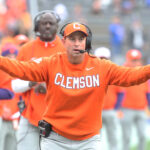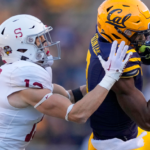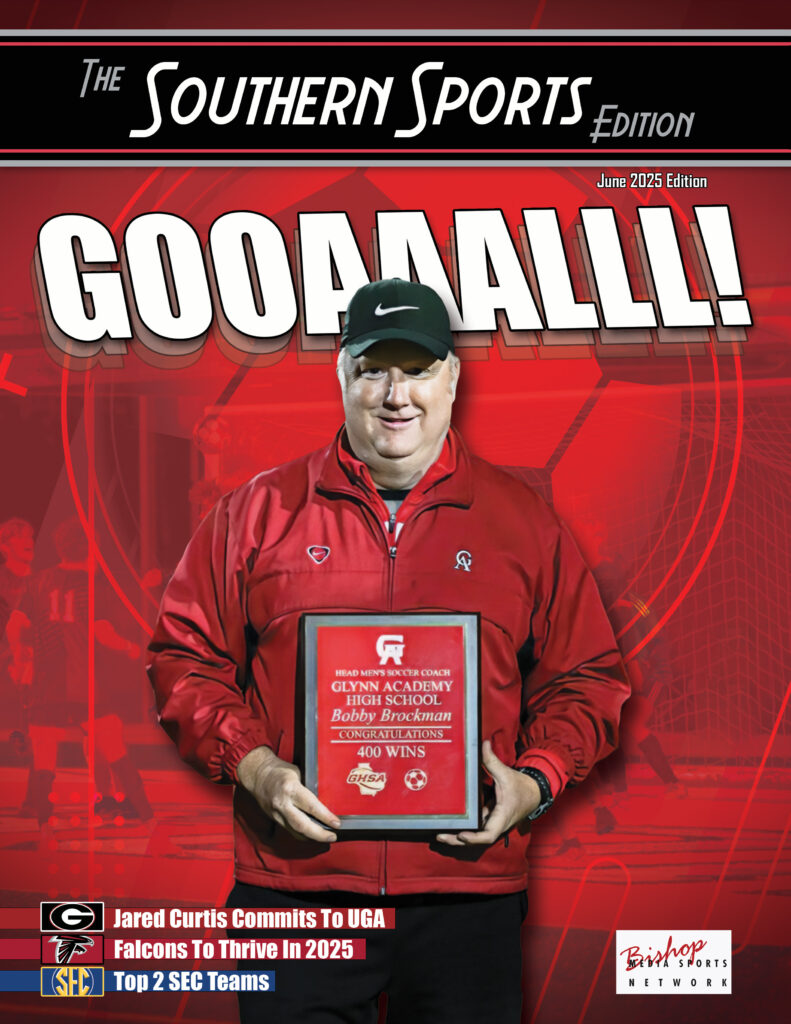SEC
Another Shake Up
 By: Michael Spiers
By: Michael Spiers
TheSouthernSportsEdition.com news services
Now that it’s been almost a month since the conclusion of the first ever 12-team college football playoff format, leaders of the two most powerful conferences are set to meet today in New Orleans, and those meetings could have a major effect on the product we watch over the next few years.
College football’s playoff system is about to get another shake-up, with serious talks of expanding to 14 or even 16 teams as early as 2026.
The Big Ten and SEC are leading the charge, pushing for automatic bids for their teams, and it looks like they’re going to get their way.
The most likely format would guarantee four spots each for the SEC and Big Ten, two each for the ACC and Big 12, and one for the highest-ranked Group of Five team. Notre Dame would also get a guaranteed spot—if it finishes in the top 14.
That means if the playoff stops at 14 teams, there might not be any extra at-large spots some years.
In this setup, the top two teams would get byes in a 14-team field, but if they go to 16 teams, nobody gets a bye—just straight into the action.
The selection committee would also take a backseat, with rankings deciding the seeds instead of a room full of administrators debating which 8-4 team is “better.”
One big change could be how conferences handle their schedules. The SEC has been debating whether to move to a nine-game conference schedule for years, and with automatic bids locked in, they might finally do it. The Big Ten already plays nine, and the ACC and Big 12 might follow.
There’s also talk of a scheduling agreement between the SEC and Big Ten, setting up big non-conference matchups like Georgia-Michigan, Texas-Ohio State, or LSU-Oregon every year. That would be great for fans, TV ratings, and—of course—revenue.
With automatic bids taking center stage, conference championship games could change or even lose some importance.
The SEC and Big Ten are looking at new ways to determine their four teams, like play-in games where, say, the third-best team plays the sixth best, and the fourth-best plays the fifth best, with the winners grabbing the last two playoff spots.
Meanwhile, the ACC and Big 12 aren’t thrilled about the SEC and Big Ten grabbing the biggest share of auto-bids.
ACC Commissioner Jim Phillips says the playoff should be “a true championship, not an invitational,” but let’s be real—the CFP has always been more of an invite system than a true playoff.
It is also important to consider the fact that ESPN is shelling out $1.3 billion a year for CFP broadcast rights starting in 2026, so they have a big say in all of this.
There are concerns that a playoff dominated by the SEC and Big Ten could push fans from other conferences away.
If the field expands to 14, there will be two extra first-round games in December, competing with the NFL.
A 16-team format would add four extra games, which could mean renegotiating TV deals to bring in even more money.
This playoff expansion is just part of a bigger power shift in college sports. The SEC and Big Ten have already secured more control over the CFP’s format and money, and they’re looking to take that influence even further.
Beyond football, these conferences—and others—are pushing for more control over things like the NCAA basketball tournament, which could also expand.
Everything is being driven by TV deals, revenue sharing with athletes, and the battle for financial dominance in college athletics.
Decisions are expected soon, but one thing’s for sure—change is coming. Whether the playoff grows to 14 or 16 teams, the SEC and Big Ten are making sure their teams are taken care of.
Conference championships might look different, scheduling could get a shake-up, and TV money will continue to drive the sport’s future.
At the end of the day, this is all about two things: more playoff spots for the biggest conferences and more money for everyone involved. Buckle up—college football’s postseason is about to get a whole new look.
College Football Super Bowl On The Way?
 By: Kipp Branch
By: Kipp Branch
TheSouthernSportsEdition.com news services
Could Clemson be moving to the SEC soon?
Rumors are swirling again regarding expansion. The SEC currently sits at 16 teams with Oklahoma and Texas joining in 2024. Think of Big 10/SEC as the NFC/AFC.
We’re quickly headed for an NFL-like model for college football because the powers that be desperately want media deals like the NFL has.
The short term will be chaotic, but it’ll eventually settle into a pro formatted league with regional divisions that prints money like the US Government.
But everything between now and then will be uncomfortable for the avid college football fan. It’s regionalized divisions within a national league. It’s how every professional sports organization is laid out.
Eventually you will see a new alignment that is consisted of the Big 10 and the SEC. You could see 24 teams in each conference breaking away from the NCAA governing body which has become useless by the way.
You could call it something like the National College Football League. You could appoint a league commissioner just like the NFL and negotiate major TV deals for each the league. All teams that are not members of the NCFL could stay as members of the toothless NCAA and still compete at football.
If Clemson bolts to the SEC, what is to stop Florida State, Miami, and North Carolina from following? You keep hearing things from people like what about Georgia Tech, Virginia, and Virginia Tech? Do you want the Big 10 to come down and gain a footprint in the South?
The answer is who cares. In the NFL you have the AFC South and the NFC South. You the AFC North and The NFC North. You see it really doesn’t matter if you land in one of the two major conferences.
What about recruiting? The top-rated recruits will go to a league that has the best TV contract, which will end up fueling NIL money into the pockets of those highly rated prospects.
This will create parity like we see in the NFL. In the NFL anyone can get beat on any given Sunday. An NFL type model in college will create anyone can get beat on any given Saturday.
What if the SEC expanded by four more teams in 2025 with Clemson, FSU, North Carolina, and Miami to put the number at 20?
The SEC could create four divisions with five teams. If a new body was formed with the Big Ten, then there would be no more cupcakes as you would only play teams from each conference.
Twelve game schedules, then two rounds of playoffs in each conference. You then have a championship Saturday with two huge conference championship games then a huge National Championship game on Saturday before the Super Bowl.
A 20-team breakout in a newly expanded SEC could look like this:
SEC Atlantic: Clemson, FSU, UNC, Miami, South Carolina
SEC East: Auburn, Georgia, Florida, Kentucky, Vanderbilt
SEC Central: Alabama, Ole Miss, LSU, Mississippi State, Tennessee
SEC West: Arkansas, Missouri, Oklahoma, Texas, Texas A&M
You would have 9 conference games annually. Each team would play everyone in their division annually. You would have one permanent opponent from the rest of conference and rotate the rest so you can play home and home with the entire conference in a 4–5-year window.
You would play 3 rotating Big 10 opponents based on a computer model that matches teams with similar records from the previous season. No more cupcakes.
The team with best overall record wins their division and makes the SEC playoffs. If there is a two-way tie in division then head-to-head tiebreaker is in effect. Further tiebreaker scenarios would be determined by league.
This model would require Notre Dame to join the Big Ten.
Put on your seat beat folks this is where college football is heading. If not two conferences, then four with similar type formats.
Rest in Peace NCAA. Can you envision a college football draft down the road with a draft order for the top high school football prospects with slotted NIL money for each pick? You talk about parity folks.
Jason Bishop Show w Kipp Branch August 11
Jason Bishop Show w Kipp Branch August 4
ACC All Gone?
 By: Robert Craft
By: Robert Craft
TheSouthernSportsEdition.com news services
The SEC and Big Ten (right now) don’t want to expand and steal someone from the ACC or Pac-12, both commissioners Greg Sankey and Tony Petitti have stated that publicly.
The potential implosion of the ACC or Pac-12 might change that. If the Pac-12 collapses or big names like North Carolina, Florida State, Clemson and the like find a way out of the ACC Grant of Rights, the Big Ten and SEC would be concerned about the other scooping up another big market name, and that changes the dynamic.
Sankey has maintained that the SEC only added Texas/Oklahoma because the schools approached the conference and SEC would have been foolish to pass. (And yes, Notre Dame is the only obvious TV additive right now if you’re the SEC or Big Ten, sorry).
If I’m the ACC, increasing my value is top priority, therefore I wouldn’t fall far behind the Big Ten and the SEC, and keep it that way until at least the end of the decade. Smart conferences will already find new revenue streams in a new and ever-evolving market.
Would a smart conference stay in contact with the Pac-12? Would some sort of scheduling alliance or partnership be available? An eye on the Pac-12; if anyone follows Colorado out the door, it could lead to total collapse.
Already, Florida State, Clemson and others have made it clear that they believe they deserve more (money). Do they see themselves splitting the pie by another four slices? Is it evenly shared? Probably not. Could you do a tiered revenue split and add a western wing? I know things are never as simple as they sound on paper, but I’d explore any option to preserve the brightest future for the program.
Of course, there is always the possibility that someone challenges the ACC’s grant of rights and tries to exit the league. Florida State has a virtual board of trustees meeting soon.
The Seminoles would have to give notice of their withdrawal from the ACC by Aug. 15 in order to compete in a new league by fall 2024 (where would they go? How much is the exit fee?).
If the ACC breaks open, we’ll have a different conversation. The ACC could keep its current membership and become an aggressor in the media profit landscape if 1) they want a fight; and 2) they don’t open up an escape for FSU or Clemson or anyone to get out of the grant of rights.
The ACC corner of realignment is the most intriguing off-field action. The more I watch, the more questions surface. The result of this conflict will set the tone and trajectory for the future of a historically competitive conference.
Save The Receipts
 By: Robert Craft
By: Robert Craft
TheSouthernSportsEdition.com news services
The recent verbal jousting over NIL between two of college football’s heavyweight head coaches, Nick Saban and Jimbo Fisher has garnered a ton of national media attention and headlines in the past few days.
The minute Alabama coach Nick Saban’s comments regarding Texas A&M and NIL showed up on social media Wednesday night, the college football world stopped to watch what happened next.
Saban further opened up about what he said during an event in Birmingham. He said Texas A&M “bought every player on their roster,” which led to a fiery press conference from Aggies coach Jimbo Fisher on Thursday.
Saban reiterated his stance on NIL and how it’s a good thing for players, but continued to call for “guardrails” to help create “parity.”
“It was not my intention to really criticize anyone,” Saban said. “I was just trying to make a point about the state of college football and college athletics right now. I think we have some unintended consequences of name, image and likeness in some of the circumstances that we’re in right now. The spirit of competition is what has made sports popular, created a lot of fan interest….But we’ve always had guardrails on rules that govern competitive sports to create parity, and I think the situation that we’re in now in college football, we don’t have that. There’s a lot of Division I schools that aren’t going to be able to do the same things that other Division I schools can do to create opportunities for players in some kind of way. I’m all for the opportunities for the players, but some way, we’ve got to create a balance in all that.”
Saban also said he worries about programs losing players to other programs because of NIL opportunities — and he called for “guardrails” to prevent that.
“I don’t want to go down that road of bidding for players out of high school. I don’t,” Saban said. “But if we go through this recruiting class this year and we lose all the players, because Jimbo Fisher has been saving the receipts.”
Texas A&M’s head coach went scorched earth Thursday during an impromptu press conference responding to comments by Alabama head coach Nick Saban, who accused Fisher and the Aggies of “buying every player on their team” through NIL deals this offseason.
Texas A&M inked the greatest recruiting class in modern history this spring, and Fisher, who has already issued multiple public statements denouncing accusations of cheating, once again doubled-down that the Aggies did nothing outside of the NCAA rules (i.e., pay for play) to land their historic class.
“It’s a shame that we have to do this,” Fisher said. “It’s really despicable. It’s despicable that somebody can say things about somebody, an organization, and more importantly 17-year-old kids. You’re taking shots at 17-year-old kids and their families. That they broke state laws, that they’re all money, that we bought every player in this group. We never bought anybody. No rules were broken. Nothing was done wrong.”
Thou doth protest too much? Too much performance art? Absolutely, but under the new NIL rules, Texas A&M could’ve totally provided six-figure deals to players. While inducements are prohibited, there’s a lot of gray area in-between.
But the mere suggestion that the Aggies’ recruiting was not above board sent Fisher into such a tizzy that he unleashed the greatest diss track since 2Pac’s Hit ‘Em Up.
The man emptied the clip on a man many considered his mentor, someone Fisher worked under for five seasons at LSU. During his opening salvo, Fisher referred to Saban as “despicable” multiple times, and called him a narcissist.
Jimbo Fisher has been saving the receipts, and his clapback is just relentless. No mercy. Who else cannot wait to be a fly on the wall when Fisher and Saban sit at the same table at the SEC Spring Meeting.
Jason Bishop Show w Kipp Branch November 27
Jason Bishop Show w Kipp Branch July 31

Lurking Gators
 By: Kenneth Harrison
By: Kenneth Harrison
TheSouthernSportsEdition.com news services
Florida (6-1) is back in familiar territory as a top 10 team and national championship contender. The Gators beat No.7 Auburn about two weeks ago.
The Tigers came into the game as the favorites but left Gainesville with a convincing 24-13 loss. Florida was feeling great after that win and headed to No. 5 LSU the following week.
UF won the game in Gainesville last season, 27-19. The Tigers had revenge on their mind and pulled away in the second half. The game was tied at 21 at halftime. LSU won 42-28.
LSU coach Ed Orgeron declared that holding Florida’s defense without a sack was “the biggest stat of the night,” noting how the Gators’ defensive ends had “destroyed” opposing offensive lines in previous games.
Kyle Trask was 23-of-39 passing for 310 yards, 3 touchdowns and 1 interception.
“There’s two ways you can go: You can either lose and start pointing fingers or you can lose and start coming together,” Trask said. “We have a great group of guys and at the end of the day; it’s just going to make this team better.”
This is the toughest part of Florida’s schedule. So far, they are 1-1 during these four games. The remaining games are at South Carolina and Georgia at a neutral site (Jacksonville).
Previously I did not think the USC game would be difficult. The Gamecocks were under .500 prior to this weekend.
They shocked the college football world by beating No. 3 UGA in Athens. The Bulldogs turned the ball over four times and South Carolina did not have any. Now this game in Columbia looks like a heavyweight matchup.
South Carolina (3-3) gave up 468 yards to Georgia but forcing the turnovers was the difference. The Gamecocks also lost freshman quarterback Ryan Hilinski to a knee injury. He’s actually a backup and has been playing since senior Jake Bentley suffered a mid-foot sprain in the season opener.
Third string freshman quarterback Dakereon Joyner played several snaps against Georgia. Currently, it does not sound like he will start the Florida game because Hilinski is expected to return.
“He’s got a sprained knee,” Muschamp said of Hilinski. “It’s nothing serious. I’ll know more Tuesday. He’s a little sore, obviously, today. But again, it’s nothing serious. We expect him to play on Saturday.”
So far, I give the early advantage to the Gators. They are ranked 20th nationally in total defense but they have played at least one more game than all of the teams ranked higher. That means they are actually better than many of them.
The Gamecocks are not good on offense and they are led by an injured true freshman QB.
If he cannot make it through the game, the third string QB will come in and they were not effective with him. They should be able to stop them and hold them to under twenty points.
I don’t think they will overlook this game since they know Carolina is capable of beating them. After that, they will go in to the bye week with two weeks to prepare against Georgia.
New Tricks Against Bama?
 By: Mike Anthony
By: Mike Anthony
TheSouthernSportsEdition.com news services
Could UGA be shut out of playoff again?
Without a doubt, the University of Georgia is in its golden age. The Bulldogs, seem to have found a generational coach in Kirby Smart, have been dominating the recruiting wars and enter 2019 as – once again – a serious contender for a national championship.
…So when is that oft-presumed second national title of the modern area finally going to arrive in Athens? Because unless the Bulldogs can solve their Alabama problem, this year isn’t going to be it.
Georgia was a powerhouse in 2018. The Bulldogs ran roughshod over everyone in their path during the regular season last fall – save for a hiccup at LSU – and looked to be objectively better than even Alabama in the SEC championship game before the wheels fell off and the Tide rolled to a thrilling comeback victory.
That seemed to be insult added to injury as just 11 months before the Bulldogs had dominated Alabama for one half of the national championship game and was just one defensive stand away from an overtime victory before seeing everything go up in smoke in the form of Tua Tagovailoa hitting DeVonta Smith for a title-winning touchdown.
Last season’s conference title game loss served as a flashpoint for the playoff selection committee to pass along a judgement that – for as much as the SEC values itself – no team is guaranteed a spot in the playoff without a conference championship to its name.
With the ACC (read: Clemson) owning two of the last three national championships and the SEC trending more towards a league that is both top and bottom-heavy, containing few solid and consistent programs in between, there just isn’t a good reason to think that the SEC should have the chance to place two teams in this year’s playoff.
And that’s where the spotlight shines brightest on Georgia.
The Bulldogs don’t play Alabama in the regular season, making it very likely that they’ll be favored in all 12 regular season games.
And unless UGA can beat hyped-up preseason teams like Notre Dame, Texas A&M and Florida while all of those schools have otherwise-great seasons and retain their initial rankings, the Bulldogs will likely run into the same hurdle as before.
If UGA wins the SEC East, it’s most likely that Alabama will be waiting in the conference championship game.
And if Georgia falls to the Crimson Tide for a third consecutive season, even an otherwise great showing in 2019 probably won’t be enough of an argument for UGA to be included in the four-team national championship playoff.
It’s a tough situation for the Bulldogs, but it’s also as simple a proposition as any team could hope for.
Find a way to win the SEC and they’re guaranteed a chance to build on the last two great seasons and possibly attain that elusive national title. At the same time, just about any loss is bound to be the sore spot in yet another great season that doesn’t quite live up to what could have been.
No one doubts that Georgia is one of the best teams in all of college football. But until the Bulldogs can prove otherwise, ‘one of the best’ is all they’ll be.










